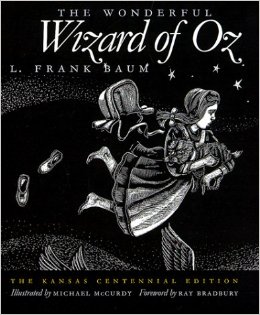
There's No Place Like Home • The Great Oz Knows Why You Have Come
How Very Resourceful • Pay No Attention to That Man Behind the Curtain


|
Authors • Illustrators • Publishers • Titles •
Years • Genre • There's No Place Like Home • The Great Oz Knows Why You Have Come How Very Resourceful • Pay No Attention to That Man Behind the Curtain |
 |
| Search | Most Recent | The Daily Ozmapolitan |
|---|---|---|
| News from Glinda's Great Book of Records |
| Wonderful Wizard of Oz, The: The Kansas Centennial Edition |
| 2000 | |
|
Author(s): Baum, Lyman Frank |
 |
|
Illustrator(s): McCurdy, Michael |
|
|
Publisher(s): University Press of Kansas, Lawrence, Kansas |
|
|
Genre(s): Fantasy Literary Criticism |
|
Comments: Dorothy and Toto are home again thanks to the University Press of Kansas' publication of The Wonderful Wizard of Oz: Kansas Centennial Edition. The wizards at the Press conceived of the edition after discovering that L. Frank Baum's book, first published in 1900, was in the public domain. The original print story about a little girl and her dog may be a surprise to Kansans familiar only with the classic 1939 film version of the Wizard of Oz. Even Judy Garland might be shocked by the new edition's black-and-white drawings by acclaimed children's book illustrator Michael McCurdy. The most provocative of McCurdy's twenty-five scratch board illustrations is the one in which Dorothy confronts the Witch. The witch has the pointed chin and bony fingers we expect from fairy tale witches, but her eye patch makes McCurdy's witch especially sinister. The Witch tricks Dorothy into giving her one of her Silver Shoes, (they are ruby slippers in the film version). With one foot bare, the angry Dorothy grabs the nearest object, a bucket of water, and throws it on the Witch. "...I never thought a little girl like you would ever be able to melt me and end my wicked deeds," wails the Witch. W.W. Denslow illustrated the first Wizard of Oz book and his illustrations have remained popular. While Denslow's illustrations are charming and whimsical, they have none of the psychological interest of McCurdy's. As unusual as McCurdy's artwork, is the new edition's forward by science fiction and fantasy author Ray Bradbury. Bradbury contrasts the Wonderful Wizard of Oz with Lewis Carrol's Alice in Wonderland. Bradbury writes, "...Lewis Carroll's cast of characters would have died here of saccharine or run back to hide behind the cold Glass. Baum settled in, delighted with bright nothings. If the Wicked Witch is truly dead it is because L. Frank Baum landed on her with his Boy's-Life-Forever-Sunkist philosophy. No witch could survive Baum, even today when witches beam themselves up." A criterion for literature to be considered classic is its ability to be reinterpreted over time. In 1964, Henry Littlefield wrote an article in the American Quarterly entitled, "The Wizard of Oz: Parable on Populism." Littlefield suggests Baum's book is an allegory for the Populist politics of the 1890s in which "led by naïve innocence and goodwill, the farmer, laborer and the politician approach the mystic holder of national power and ask for personal fulfillment." Baum was aware that a story holds different meanings for different ages. In the forward to the original Oz, Baum notes that most horrible characters and disagreeable incidents have been eliminated from modern fairy tales. "Having this thought in mind, the story... was written solely to please children of today. It aspires to be a modernized fairy tale, in which wonderment and joy are retained and the heartaches and nightmares are left out." One-hundred years after its initial publication, the children's classic The Wonderful Wizard of Oz by L. Frank Baum remains worthy of reading by every Kansan regardless of age. However, in Michael McCurdy's illustrations, adults may find new meaning for an old children's story. |
| ©2002-2026 Blair Frodelius • Blair & Co. |